
Psidium is a genus of trees and shrubs in the family Myrtaceae. It is native to warmer parts of the Western Hemisphere. Many of the species bear edible fruits, and for this reason several are cultivated commercially. The most popularly cultivated species is the common guava, Psidium guajava.
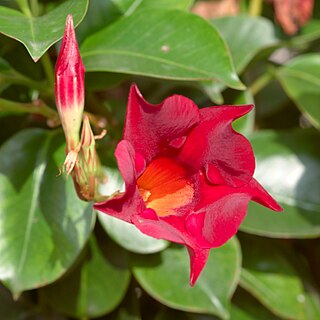
Mandevilla is a genus of tropical and subtropical flowering vines belonging to the family Apocynaceae. It was first described as a genus in 1840. A common name is rocktrumpet.
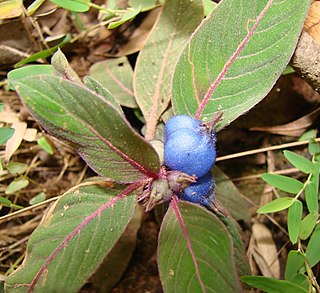
Coccocypselum is a genus of flowering plants in the family Rubiaceae. It is native to Mexico, Central America, the West Indies and South America. All species of the genus Coccocypselum are herbaceous with fleshy, blue or purple fruits, and 4-petaled flowers.
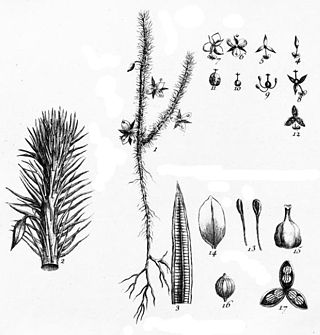
Mayaca is a genus of flowering plants, often placed in its own family, the Mayacaceae. In the APG II system of 2003, it is assigned to the order Poales in the clade commelinids. The Cronquist system, of 1981, also recognised such a family and placed it in the order Commelinales in the subclass Commelinidae.

Caryocar is a genus of flowering plants, in the South American family Caryocaraceae described as a genus by Linnaeus in 1771. It is native primarily to South America with a few species extending into Central America and the West Indies.
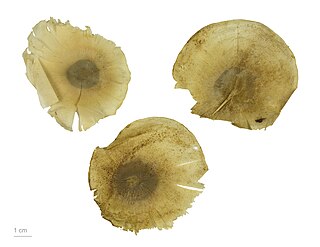
Aspidosperma is a genus of flowering plant in the family Apocynaceae, first described as a genus in 1824. It is native to South America, Central America, southern Mexico, and the West Indies.

Forsteronia is a genus of plants in the family Apocynaceae, first described as a genus in 1818. It is native to South America, Central America, Mexico, and the West Indies.
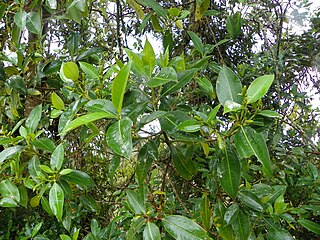
Hedyosmum is a genus of flowering plants in the family Chloranthaceae. There are about 40 to 45 species. They are distributed in Central and South America and the West Indies, and one species also occurs in southeastern Asia. They are mostly dioecious, except for H. nutans and H. brenesii which are exclusively monoecious, and H. scaberrimum and H. costaricense with both monoecious and dioecious individuals.
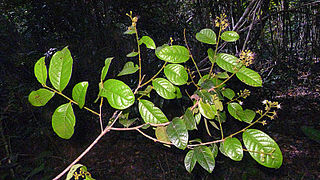
Hirtella is a genus of 110 species of woody trees in family Chrysobalanaceae. It was first described as a genus by Linnaeus in 1753. Hirtella naturally occurs in tropical forests throughout Latin America, the West Indies, southeast Africa, and Madagascar. The flowers are mainly pollinated by butterflies.

Axonopus is a genus of plants in the grass family, known generally as carpet grass. They are native primarily to the tropical and subtropical regions of the Americas with one species in tropical Africa and another on Easter Island. They are sometimes rhizomatous and many are tolerant of periodic submersion.
Isocarpha (pearlhead) is a genus of flowering plants in the family Asteraceae. They are native to Mexico, Central America, the West Indies, and northern South America, with the range of one species extending north into the United States.

Chiococca is a genus of flowering plants in the family Rubiaceae. It currently holds 23 species that are native to Florida, Texas, Mexico, Central America, much of South America, the West Indies, and the islands of Galápagos and Fernando de Noronha.

Macradenia is a genus of flowering plants from the orchid family, Orchidaceae. It is native to Latin America, the West Indies and Florida.
- Macradenia amazonicaMansf. - Brazil
- Macradenia brassavolaeRchb.f. - southern Mexico, Central America, Colombia, Venezuela, Ecuador
- Macradenia delicatulaBarb.Rodr. - Minas Gerais
- Macradenia loxoglottisFocke ex Rchb.f. in W.G.Walpers - Suriname
- Macradenia lutescensR.Br. - Florida, Bahamas, Cuba, Dominican Republic, Jamaica, Trinidad, Venezuela, Colombia, Guyana, Suriname, French Guiana, Brazil, Colombia, Ecuador
- Macradenia multiflora(Kraenzl.) Cogn. in C.F.P.von Martius - Brazil, Paraguay
- Macradenia paraensisBarb.Rodr. - Brazil, Paraguay
- Macradenia paulensisCogn. in C.F.P.von Martius - Brazil
- Macradenia purpureorostrataG.Gerlach - Colombia, Venezuela
- Macradenia regnelliiBarb.Rodr. - Minas Gerais
- Macradenia rubescensBarb.Rodr. - Brazil, Venezuela
- Macradenia tridentataC.Schweinf. - Peru

Prescottia is a genus of flowering plants from the orchid family, Orchidaceae. It is widespread across much of Latin America and the West Indies, with one species (P. oligantha) extending into Florida.

Psilochilus is a genus of flowering plants from the orchid family, Orchidaceae. It is native to South America, Central America, Mexico and the West Indies.
- Psilochilus carinatusGaray - Colombia
- Psilochilus dusenianusKraenzl. ex Garay & Dunst. - Venezuela, Brazil
- Psilochilus macrophyllus(Lindl.) Ames - widespread from central Mexico and the West indies south to Peru
- Psilochilus maderoi(Schltr.) Schltr. - Colombia
- Psilochilus modestusBarb.Rodr. - Venezuela, Brazil
- Psilochilus mollisGaray - Ecuador
- Psilochilus physurifolius(Rchb.f.) Løjtnant - Venezuela, Guyana
- Psilochilus vallecaucanusKolan. & Szlach. - Colombia

Chomelia is a genus of flowering plants in the family Rubiaceae. It is native to Mexico, Central America, the West Indies, and much of South America as far south as Argentina.

Calycophyllum is a genus of flowering plants in the family Rubiaceae. It was described by Augustin Pyramus de Candolle in 1830. The genus is found from Mexico, Central America, South America and the West Indies.
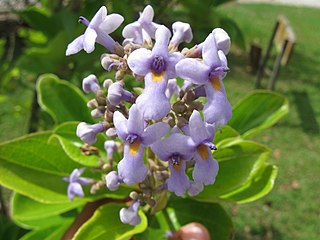
Cornutia is a genus of plants in the family Lamiaceae, first described in 1753. Species in this genus are native to tropical parts of the Western Hemisphere, including southern Mexico, Central America, the West Indies, and northern South America.
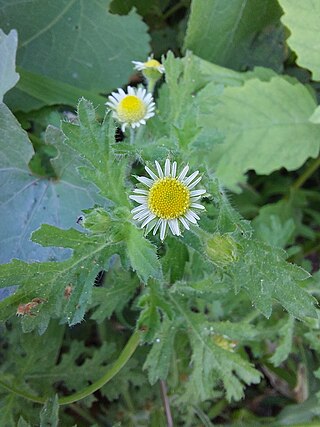
Egletes viscosa, the erect tropical daisy, is a New World species of flowering plant in the family Asteraceae. It is widespread across much of South America, Central America, Mexico, and the West Indies, just barely crossing the US border into the southernmost county in Texas.
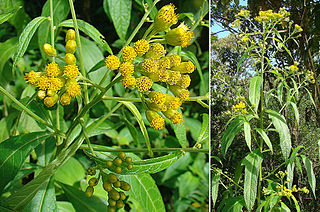
Neurolaena lobata, commonly known as jackass bitters, is a species of perennial flowering plant in the family Asteraceae. It is found in Mexico, Central America, South America, and the West Indies.



















